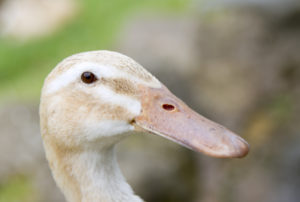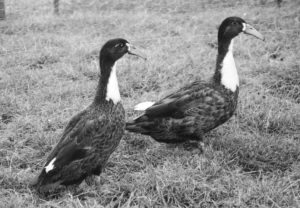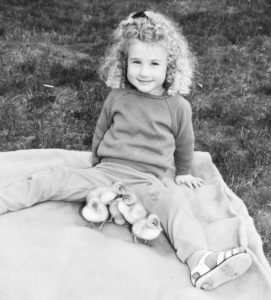Dave Holderread has raised and studies ducks for 50 years. He taught applied poultry science in Puerto Rico before he and his wife Millie established one of the largest genetic stocks of domestic waterfowl in the world on their farm in Oregon. This excerpt about the need to preserve rare breeds is from Storey’s Guide to Raising Ducks, 2nd Edition, © by Dave Holderrread, used with permission from Storey Publishing.
The Importance of Rare Breeds
For thousands of years people throughout the world have raised animals for companionship, work, food, clothing, pest control, beauty, and sport. Sometimes by chance but often by design, through the generations animals were selected that were well suited for specific tasks or environments. Soon after the turn of the twentieth century, the number of breeds of domesticated animals approached its zenith. Farm animals were suited to an amazing array of environments and uses.

Close up image of female Silver Appleyard Duck
As early as the 1920s, a new trend began to emerge. The mechanization and specialization of farms ushered in an era when fewer and fewer breeds were relied on to produce food. The livestock and poultry industries focused increasingly on specialized breeds and hybrids that could be packed tightly in minimal space. Improved yields and greater efficiency became the rallying cry of the “modern” agriculturists. With uncanny speed this tunnel vision led to near decimation, or in some cases total loss, of various old breeds.
By the 1960s whispers of warning could be heard. Some stubborn farm folks who had turned a deaf ear to the “experts” insisted that the old breeds still had their place in the modern world. In the halls of academia, a few forward-thinking geneticists pointed out that the losses of genetic stocks of plants and animals, both wild and domestic, could have profoundly negative effects on the quality of life on planet Earth, even decreasing humans’ chances for long-term survival.

The Dutch Hook Bill has been traced to the 1600s; it nearly became extinct before a few breeders in Holland, Germany, and England saved the breed in the latter part of the twentieth century. This ten-week-old pair was part of the first documented clutch of Hook Bill ducklings hatched in North America. This fascinating breed, which we imported in spring 2000 and are breeding and studying at our Waterfowl Farm, comes in white-bibbed (shown here), nonbibbed, and pure white.
How You Can Help
As we head into the twenty-first century, preserving the widest possible gene pool in all types of plants and animals is essential. Around the world, geneticists, trained plant and animal breeders, and — just as important — thousands of lay people are dedicated guardians of endangered genetic stocks of all kinds. A variety of organizations now promote this work, including Seed Savers and National Germplasm Repositories (for plants) and the American Livestock Breeds Conservancy, the Society for the Preservation of Poultry Antiquities, and the International Registry of Poultry Genetic Stocks (for animals and fowl).
[Community Chicken Editor note: the link for the Society for the Preservation of Poultry Antiquities leads to their Facebook page; the International Registry of Poultry Genetic Stocks link takes you to a .pdf open access copy of Dr. Ralph G. Somes original publication.]
Keep Rare Breeds
One of the most important contributions you can make is to raise one or more of the rare breeds. By purchasing endangered breeds you make three important contributions: You support the farms that breed them, you increase the populations of the breeds, and you augment the number of locations where the breeds are kept, thus reducing the possibility that they could be wiped out by plague, marauding predators, or natural disasters. Some people are concerned that if they buy rare breeds and then butcher them they are hurting the preservation efforts. Actually, they are helping by increasing demand for the breed and utilizing them for one of their original purposes.
Multiply Rare Breeds
A step beyond simply keeping rare ducks is breeding them. By propagating them you are increasing their numbers and providing yourself with additional birds from which to select future breeding stock. And you can distribute birds to other interested persons.
If you raise a sufficient number of young birds each year, you can retain the best specimens for your own breeding flock or distribute them to other people, and the less typical specimens can be used for food, pets, or decoration. If you save the superior specimens for breeding each year, you will maintain the overall quality of the gene pool or, better yet, improve it
Learn about Your Chosen Breeds
Learning the history, conformation, color, and other characteristics of chosen breeds can increase your enjoyment, improve your ability to select breeding stock, and make you a better rare-breeds promoter. When promoting rare breeds, remember that people are usually attracted to a particular breed for one or more of the following reasons: appearance, practical qualities, or history. Experience has shown that the more one is engaged with the story of a breed, the more likely one is to continue raising it.
Exhibit Your Rare Breeds
One of the best ways to introduce people to heritage breeds and create interest is to exhibit your rare birds at county, state, provincial, or poultry club shows. When you are showing rare breeds or varieties, a wonderful way to educate people is to prepare a poster or card that gives pertinent breed information and place it on or near the display cage of the birds.
Ancona Ducks
Origin: Great Britain
Weight: 5 to 7 pounds (2.25 to 3 kg)
Color Varieties: Black, Blue, Chocolate, Lavender, and Silver
Practical Qualities: Excellent layers (210 to 280 per year) of white, cream, green, blue, or spotted eggs; high-quality meat; excellent foragers that eat large quantities of slugs, snails, and insect pests; easy to see in field or on pond.
Characteristics: The plumage pattern is broken with irregular white spots and patches throughout; seldom are two individuals marked exactly alike; the bill and feet are spotted.
Status: Extremely rare
For more information contact: (your name, address, phone number)

Ancona Duck
If printed on paper, this card can be affixed to a slightly larger piece of ¼-inch plywood, outfitted with two opened paper clips, and hung on a cage. You should ask the show superintendent for permission — in our experience superintendents have always been pleased with these information plaques because they add class and interest to a show.
An additional way to disseminate information at shows is to make a simple wooden holder for free flyers that describe your efforts (or others’) to improve and preserve rare breeds. The holder with flyers can be placed in a prominent location, such as on top of the show cage.
Some rare breeds, because of their scarcity, have not been officially recognized by the American Poultry Association (APA), even if they are recognized in their country of origin. Some shows will accept competition entries only for the breeds and varieties officially recognized by the APA, but most shows will accept entries of rare breeds even if they are not in the American Standard of Perfection. Even those shows that do not accept nonstandard breeds for competitive classes normally will allow them to be entered for display.
Support Heritage Breed Organizations
There are a number of organizations that are dedicated to helping preserve rare breeds of livestock. They publish newsletters, sponsor seminars, and do a variety of promotional work. Supporting them with your membership can increase your knowledge and ability to work effectively for the good of heritage breeds.
Help Standardize a Rare Breed
One step in helping increase the chances of survival of a breed is getting it recognized by the American Poultry Association. Once a breed is officially standardized, there is more incentive for specialty breeders and exhibitors to raise and show it, which in turn increases the breed’s exposure to the public. Currently, the procedure for getting a breed standardized by the APA includes the following:
- At least five people must raise the breed for a minimum of 5 years each.
- A standard description of size, shape, and color is prepared for the breed.
- At the end of the 5 years, at least five exhibitors must show a minimum of 50 specimens at a qualifying meet.
- The judge of the qualifying meet must recommend to the APA board of directors that the breed be admitted due to sufficient uniformity as well as conformity to the written standard.
- The APA board of directors votes on admittance.
While the task of getting a breed officially recognized sounds a bit arduous, it is feasible when a group of breeders pitches in to help.

The Primary Purpose of conserving rare breeds is for the benefit of future generations. Our niece Maggie, shown here at three years old, delights in watching over these day-old Saxony ducklings.













1 Comment
Rare breed conservation and research is a excellent and very essential task for us now a days. I have much more interest in this work area. I myself working about last 30 years in livestock production. presently working in a research project in Hill livestock production (chicken and sheep) in Bangladesh as research officer. It is a collaborative project with a national research institute and a Veterinary and Animal Sciences University funded by Agriculture Research Foundation in Bangladesh. please make a forum for rare animal conservation world wide.